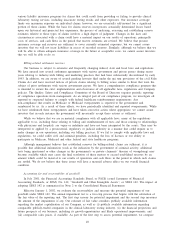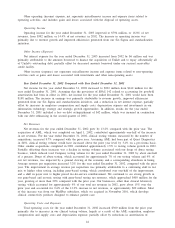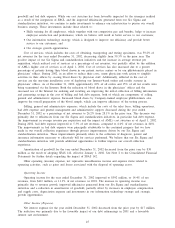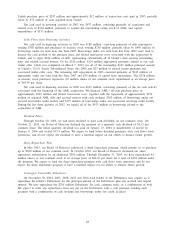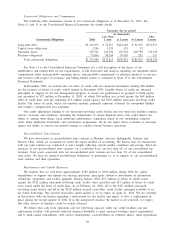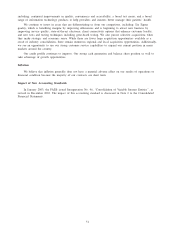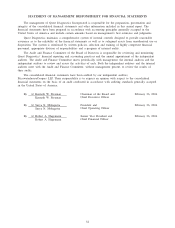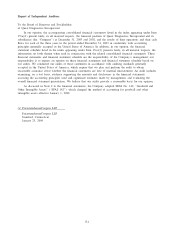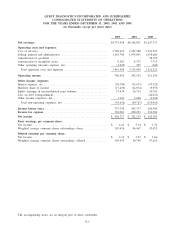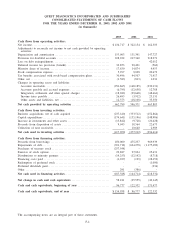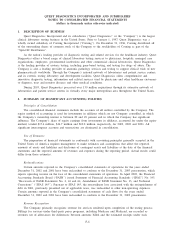Quest Diagnostics 2003 Annual Report Download - page 67
Download and view the complete annual report
Please find page 67 of the 2003 Quest Diagnostics annual report below. You can navigate through the pages in the report by either clicking on the pages listed below, or by using the keyword search tool below to find specific information within the annual report.and additional growth opportunities for the foreseeable future, exclusive of any potential temporary impact of
the Health Insurance Portability and Accountability Act of 1996, as discussed below. Our investment grade
credit ratings have had a favorable impact on our cost of and access to capital, and we believe that our
improved financial performance should provide us with access to additional financing, if necessary, to fund
growth opportunities that cannot be funded from existing sources.
Health Insurance Portability and Accountability Act of 1996
The Secretary of the Department of Human Health and Services, or HHS, has issued final regulations
under the Health Insurance Portability and Accountability Act of 1996, or HIPAA, designed to improve the
efficiency and effectiveness of the healthcare system by facilitating the electronic exchange of information in
certain financial and administrative transactions while protecting the privacy and security of the information
exchanged. Three principal regulations have been issued: privacy regulations, security regulations, and standards
for electronic transactions.
We implemented the HIPAA privacy regulations by April 2003, as required, and are conducting an analysis
to determine the proper security measures to reasonably and appropriately comply with the standards and
implementation specifications by the compliance deadline of April 20, 2005.
The HIPAA regulations on electronic transactions, which we refer to as the transaction standards, establish
uniform standards for electronic transactions and code sets, including the electronic transactions and code sets
used for claims, remittance advices, enrollment and eligibility.
On September 23, 2003, CMS announced that it would implement a contingency plan for the Medicare
program to accept electronic transactions that are not fully compliant with the transaction standards after the
October 16, 2003 compliance deadline. The CMS contingency plan, as announced, allows Medicare carriers to
continue to accept and process Medicare claims in the pre-October 16 electronic formats to give healthcare
providers additional time to complete the testing process, provided that they continue to make a good faith
effort to comply with the new standards. Almost all other payers have followed the lead of CMS, accepting
legacy formats until both parties to the transactions are ready to implement the new electronic transaction
standards.
As part of its plan, CMS is expected to regularly reassess the readiness of its healthcare providers to
determine how long the contingency plan will remain in effect. Many of our payers were not ready to
implement the transaction standards by the October 2003 compliance deadline or were not ready to test or
trouble-shoot claims submissions. We are working in good faith with payers that have not converted to the new
standards to reach agreement on each payer’s data requirements and to test claims submissions.
The HIPAA transaction standards are complex, and subject to differences in interpretation by payers. For
instance, some payers may interpret the standards to require us to provide certain types of information,
including demographic information not usually provided to us by physicians. As a result of inconsistent
interpretation of transaction standards by payers or our inability to obtain certain billing information not usually
provided to us by physicians, we could face increased costs and complexity, a temporary disruption in receipts
and ongoing reductions in reimbursements and net revenues. We are working closely with our payers to
establish acceptable protocols for claims submissions and with our trade association and an industry coalition to
present issues and problems as they arise to the appropriate regulators and standards setting organizations.
Compliance with the HIPAA requirements requires significant capital and personnel resources from all healthcare
organizations. While we believe that our total costs to comply with HIPAA will not be material to our results
of operations or cash flows, additional customer contact to obtain data for billing as a result of different
interpretations of the current regulations could impose significant additional costs on us.
Outlook
As discussed in the Overview, we believe that the underlying fundamentals of the diagnostic testing
industry will continue to improve and that the growth in the market for laboratory testing will accelerate over
the long term. We believe that in the short term, the market will continue to expand, despite the negative
impact which the current levels of unemployed and uninsured, and healthcare plan design changes are having on
our business. As the leading national provider of diagnostic testing, information and related services with the
most extensive network of laboratories and patient service centers throughout the United States, we expect to
further enhance patient access and customer service. We provide a broad range of benefits for customers
50


